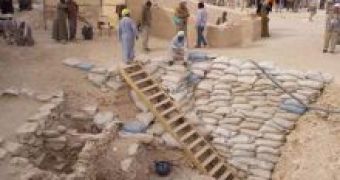For nearly a century it was believed that nothing sensational is left to be discovered in the Valley of the Kings. Not so! A team of archeologists lead by Otto Schaden, from Memphis University in Unites Sates, has uncovered another intact tomb containing five or six sarcophagi.
In spite of what it said yesterday, Egypt's antiquities authority didn't provide much information today. It has only reported that the tomb has a single chamber which contains five wooden sarcophagi, in human shapes with colored funerary masks, surrounded by 20 jars with their pharaonic seals intact. The sarcophagi contain mummies, likely from the 18th Dynasty, some 3,500-3,300 years ago. In addition to the five sarcophagi there seems to be another one placed on top of two of the other coffins, but Egypt's antiquities authority have only mentioned five sarcophagi.
The Supreme Council of Antiquities revealed some photos of the interior of the tomb - the bare stone walls undecorated - with the sarcophagi of blackened wood amid white jars, some of which appear to be broken.
Besides the value of the actual discovery, this also raises hopes that more is to be found in the Valley of the Kings. "I wouldn't be surprised if we discover more tombs in the next 10 years. For a long time, people thought there was nothing left to find and excavations seemed unlikely to produce much. So instead, they concentrated on recording what was already there,'' said archeologist Kent Weeks who back in 1995 had discovered that the tomb of Ramses II was far larger than expected, and who examined the photos.
Weeks said the sarcophagi were clearly not designed to be in this tomb, because usually each chamber had only one sarcophagus. Thus, the tomb probably was used as a storeroom either by priests wanting to protect the sarcophagi from thieves, or by thieves themselves stashing them here but for some reason failing to return for them. The archeologist said that the jars appear to be meat jars for food offerings.
Next, archeologists will date each mummy in order to see to which one, if any, the tomb belongs. The tomb can be dated based on its architecture - early New Kingdom tombs have doors of different width and height than later ones. The archeologists will also look for inscriptions on the sarcophagi and will study the wrappings and other materials used in the mummies. This can also give hints about their age.
Photo credits: AP Photo/Supreme Council of Antiquities

 14 DAY TRIAL //
14 DAY TRIAL //